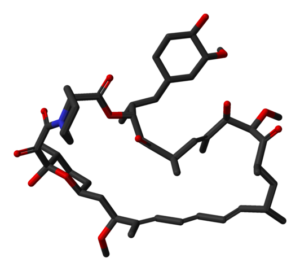A study recently published in the medical journal, Aging Cell, outlines how a compound known as rapamycin may help to suppress neurological damage. This research could lead to new therapeutic approaches to address neurological diseases such as Alzheimer’s and dementia.

The scientists at Oregon State University who conducted the study found that rapamycin can help minimize damage related to cellular senescence.
“The value of rapamycin is clearly linked to the issue of cellular senescence, a stage cells reach where they get old, stop proliferating and begin to secrete damaging substances that lead to inflammation,” said Viviana Perez, one of the authors of the study. “Rapamycin appears to help stop that process.”

Stick model of the molecule.
The secretion of harmful compounds by cellular senescence creates a toxic environment called senescence-associated secretory phenotype, or SASP. It’s thought that SASP ultimately hampers cells’ functionality and disrupts tissue structure and function.
“The increase in cellular senescence associated with aging and the inflammation associated with that can help set the stage for a wide variety of degenerative disease, including cancer, heart disease, diabetes and neurologic diseases, such as dementia or Alzheimer’s,” Perez said. “In laboratory animals when we clear out senescent cells, they live longer and have fewer diseases. And rapamycin can have similar effects.”
Rapamycin Has Been Studied Extensively
Rapamycin is a natural compound. It has been widely studied because it can produce results similar to dietary restriction, which has proven to extend some animals’ lifespans. Lab mice that receive the compound have demonstrated better fitness, less cancer, improved cognition, longer life and other positive effects.

Rapamycin was first discovered in the soils of Easter Island in the South Pacific Ocean.
Before the new research, scientists had only known of one way that rapamycin could affect cellular senescence. It was believed that the compound helped to increase the function of Nrf2, a regulator that “turns on” roughly 200 genes that ultimately help reduce levels of SASP. The new study concludes that rapamycin could also directly affect levels of SASP, separately from the Nrf2 pathway.
“Any new approach to help protect neurons from damage could be valuable,” Perez said. “Other studies, for instance, have shown that astrocyte cells that help protect neuron function and health can be damaged by SASP. This may be one of the causes of some neurologic diseases, including Alzheimer’s disease.”
Rapamycin for human use has been largely constrained by a side effect that increases insulin resistance. This could elevate the risk for diabetes. Since that risk exists, the use of the compound in humans to alleviate degenerative neurological disease remains limited. Scientists are working to find compounds similar to rapamycin that have the same biological benefit and don’t cause the unfortunate side effect.

 Rapamycin Could Help Address Neurologic Damage Associated with Aging
Rapamycin Could Help Address Neurologic Damage Associated with Aging


 John Mulaney’s “Funeral Planning” on Netflix: No Real Plan
John Mulaney’s “Funeral Planning” on Netflix: No Real Plan
















